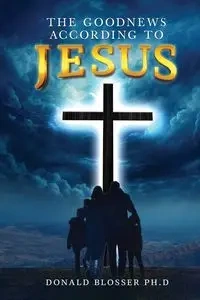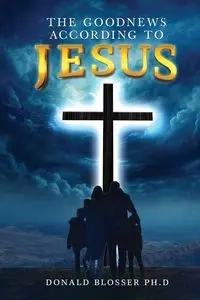The Goodnews According to Jesus - Donald Blosser
For about 40 years after the death of Jesus, the early Jesus followers met together for worship and to share their memories about what Jesus said and did. Their memory of who Jesus was, what he had done. But their memory was directly affected by the crucifixion and resurrection of Jesus. They needed an explanation for the crucifixion of Jesus that gave meaning and purpose for that horrible event. Several explanations gradually emerged that drew on their religious practice of sacrifice for forgiveness. If you wanted to be forgiven, you went to the temple and sacrificed an innocent animal. God would see that act, and would respond (according to the temple priests) by forgiving your sins.
Gradually the early followers of Jesus began to see Jesus as God's ultimate sacrifice to forgive their sins. Thus in Christian story telling the death of Jesus was seen as the intentional act of God to forgive sins. No human death could do that, because all humanity was sinful and thus they could only die for their own sins. But since Jesus was sinless, his crucifixion death was an effective God act of forgiving the sins of humanity.
In more recent years that Substitutionary Atonement explanation for the death of Jesus has been challenged. What does it say about God if God had to have one person killed before God could forgive other people? And if this excruciatingly painful death of Jesus is essential for human salvation, the teachings and life of Jesus loses its meaning (except that Jesus has to be sinless because if he had ever sinned his death would have no salvation impact for others.)
In this book Blosser takes a creative approach that emphasizes the life and teachings of Jesus asking whether Jesus saw his mission as coming to die for the redemption of humanity, or whether Jesus believed that he had come to proclaim how God would have us live together as a living witness to God's intention for the salvation of all humanity.
In other words, did Jesus see himself as God's sacrificial lamb, or was he a living prophet in
the tradition of Isaiah and other Old Testament prophets proclaiming God's intention for all humanity?
Blosser is careful as he reports on the words and actions of Jesus because he is fully aware of how many Christian believers are locked into one (and only one) explanation for the life and the death of Jesus. He challenges the reader to step outside traditional religious thinking and allow the text to let Jesus speak for himself.
From his early days when he gave a clear explanation of his earthly mission to his hometown synagogue at Nazareth (Luke 4:16-30), to his radical "cleansing" of the temple, and ending with his post resurrection instructions for the disciples, Blosser sees a consistent Jesus message that focuses on the ministry and teachings of Jesus. He also recognizes the symbolic message given by Jesuse also recognizes the symbolic in the "Cleansing of the temple" (Mark 11 ' John 2). This was a deliberate, intentional act by Jesus which challenged the heart of Jewish sacrificial activities in the temple. In this particular act, Jesus criticized the Jewish practice of killing innocent animals for the purpose of being forgiven by God. By his dramatic action, Jesus told the priests to stop this practice, that the temple was to be a place of prayer not of bloody sacrifice. And here Blosser makes an important point. If Jesus was saying by this action that the slaughter of animals is not God's way of achieving salvation, is it not logical to suggest that God would not have an innocent Jesus killed as a sacrificial lamb so that God could forgive others.
EAN: 9781962730327




For about 40 years after the death of Jesus, the early Jesus followers met together for worship and to share their memories about what Jesus said and did. Their memory of who Jesus was, what he had done. But their memory was directly affected by the crucifixion and resurrection of Jesus. They needed an explanation for the crucifixion of Jesus that gave meaning and purpose for that horrible event. Several explanations gradually emerged that drew on their religious practice of sacrifice for forgiveness. If you wanted to be forgiven, you went to the temple and sacrificed an innocent animal. God would see that act, and would respond (according to the temple priests) by forgiving your sins.
Gradually the early followers of Jesus began to see Jesus as God's ultimate sacrifice to forgive their sins. Thus in Christian story telling the death of Jesus was seen as the intentional act of God to forgive sins. No human death could do that, because all humanity was sinful and thus they could only die for their own sins. But since Jesus was sinless, his crucifixion death was an effective God act of forgiving the sins of humanity.
In more recent years that Substitutionary Atonement explanation for the death of Jesus has been challenged. What does it say about God if God had to have one person killed before God could forgive other people? And if this excruciatingly painful death of Jesus is essential for human salvation, the teachings and life of Jesus loses its meaning (except that Jesus has to be sinless because if he had ever sinned his death would have no salvation impact for others.)
In this book Blosser takes a creative approach that emphasizes the life and teachings of Jesus asking whether Jesus saw his mission as coming to die for the redemption of humanity, or whether Jesus believed that he had come to proclaim how God would have us live together as a living witness to God's intention for the salvation of all humanity.
In other words, did Jesus see himself as God's sacrificial lamb, or was he a living prophet in
the tradition of Isaiah and other Old Testament prophets proclaiming God's intention for all humanity?
Blosser is careful as he reports on the words and actions of Jesus because he is fully aware of how many Christian believers are locked into one (and only one) explanation for the life and the death of Jesus. He challenges the reader to step outside traditional religious thinking and allow the text to let Jesus speak for himself.
From his early days when he gave a clear explanation of his earthly mission to his hometown synagogue at Nazareth (Luke 4:16-30), to his radical "cleansing" of the temple, and ending with his post resurrection instructions for the disciples, Blosser sees a consistent Jesus message that focuses on the ministry and teachings of Jesus. He also recognizes the symbolic message given by Jesuse also recognizes the symbolic in the "Cleansing of the temple" (Mark 11 ' John 2). This was a deliberate, intentional act by Jesus which challenged the heart of Jewish sacrificial activities in the temple. In this particular act, Jesus criticized the Jewish practice of killing innocent animals for the purpose of being forgiven by God. By his dramatic action, Jesus told the priests to stop this practice, that the temple was to be a place of prayer not of bloody sacrifice. And here Blosser makes an important point. If Jesus was saying by this action that the slaughter of animals is not God's way of achieving salvation, is it not logical to suggest that God would not have an innocent Jesus killed as a sacrificial lamb so that God could forgive others.
EAN: 9781962730327

